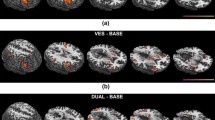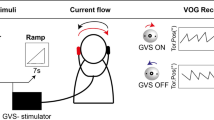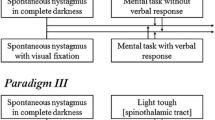Abstract.
Small-field optokinetic nystagmus (OKN) was performed in seven healthy volunteers in order to analyze the activation and deactivation patterns of visual motion, ocular motor, and multisensory vestibular cortex areas by means of fMRI during coherent visual motion stimulation. BOLD signal decreases (deactivations) were found in the first and second long insular gyri and retroinsular areas (the human homologue of the parietoinsular vestibular cortex and the visual posterior sylvian area in the monkey) of both hemispheres, extending into the transverse temporal gyrus and inferior-anterior parts of the superior temporal gyrus (BA 22), and the precentral gyri at two separate sites (BA 4 and 6). Further deactivations were found in cranioposterior parts of the superior temporal gyrus (BA 22) and the adjacent inferior parietal lobule (BA 40), anterior cingulate gyrus, hippocampus, and corpus callosum. Most of these BOLD signal decreases involved parts of the "multisensory vestibular cortical circuit". These findings support the concept of a reciprocally inhibitory visual–vestibular interaction that has now been demonstrated not only for large-field visual motion stimulation that induces vection (without eye movements) but also for optokinetically induced eye movements (without vection). The functional significance of this concept may be related to the perception of self-motion, since both large-field visual motion stimulation and optokinetic nystagmus are linked to the visual control of self-motion. With respect to activation of the cortical ocular motor system two separate and distinct areas of activations were delineated in the precentral sulcus of both hemispheres, one ventrolaterally (in BA 9) and the other dorsomedially at the junction of the superior frontal sulcus with the precentral sulcus (in BA 6). Both probably correspond to different subregions of the frontal eye field and the premotor cortex for the ocular motor performance of OKN.
Similar content being viewed by others
Author information
Authors and Affiliations
Additional information
Electronic Publication
Rights and permissions
About this article
Cite this article
Dieterich, M., Bense, S., Stephan, T. et al. fMRI signal increases and decreases in cortical areas during small-field optokinetic stimulation and central fixation. Exp Brain Res 148, 117–127 (2003). https://doi.org/10.1007/s00221-002-1267-6
Received:
Accepted:
Issue Date:
DOI: https://doi.org/10.1007/s00221-002-1267-6




